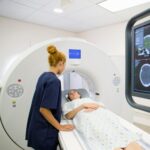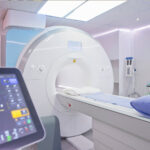Radiologic Technology Week (N.R.T.W.) is held the week of November 8 to celebrate Wilhelm Conrad Röntgen’s discovery of the X-ray — from November 2 to 8 this year. It is commemorated every year to honor the essential work of R.T.s around the country. The week-long event highlights the critical role that medical imaging and radiation treatment specialists perform in Patient Care and Medical Safety.
History of Rad Tech Week
Radiologic Technology Week was established in 1979 by the American Society of Radiologic Technologists. Historically, N.R.T.W. has not always been held in November. The first National Radiologic Technology Week was held from July 22 to 29, 1979, which was over 40 years ago. The date of the commemoration was later changed to the week of November 8. This was to honor the discovery of the X-ray by German physicist Wilhelm Röntgen on November 8, 1895.
Although Röntgen was not the first to detect X-rays, he was the first to publish a study on the subject. He labeled this radiation with the letter ‘X’ to indicate that it was an unknown form of radiation. He created the first X-ray image of a human body using these previously unknown rays and his wife’s hand. X-ray imaging’s medical applications were instantly obvious. People were employing X-rays in clinical settings within weeks of Röntgen’s revelation. Other types of radiology did not appear until much later. Godfrey Hounsfield did not develop computed tomography (C.T. scan) until 1972. In the late 1970s, real-time ultrasound equipment was introduced to the medical world.
A woman couldn’t see the fetus inside her womb before this technology. Raymond Vahan Damadian designed a magnetic resonance imaging scanner (M.R.I) in 1977. All of these inventions have proven critical in the diagnosis of various diseases.
Imaging operations and radiation therapy treatments are performed by radiologic technologists or R.T.s. Radiologists read and interpret medical images, and they collaborate with them. M.R.I., X-ray imaging, mammography, C.T. scans, ultrasound, sonography, PET, and fluoroscopy are all examples of this.
Rad Tech Week timeline
Wilhelm Conrad Röntgen creates the first X-ray on November 8.
Godfrey Hounsfield develops computed tomography otherwise known as the C.T. scan.
Raymond Vahan Damadian invents the M.R.I., a scanner for magnetic resonance imaging.
The first N.R.T.W. is held from July 22 to 29.
Rad Tech Week FAQs
Are radiologic technicians well-compensated?
In May 2020, the average yearly wage for radiologic technologists was $61,900. The bottom 10% of earners made less than $42,180, while the top 10% made over $92,660.
Is there a demand for rad techs?
It’s a high-demand job with room for advancement. According to the United States Department of Labor, the number of radiology technologists working in the United States will increase by 13% come 2026. There were 241,700 jobs in 2016; by 2026, the number is predicted to reach 272,000.
What is the average length of time it takes to become a radiology technician?
A 2-year associate’s degree in rad tech is typical for radiologic technologists. Students can attempt the California State exam for therapeutic or diagnostic radiologic technology certification after completing their degree.
How to Observe Rad Tech Week
Spread the word
Put up posters and exhibits regarding medical imaging and radiation therapy in your workplace. Employees and customers can be reached by strategically placing the displays.
Hold a fundraiser
Fundraisers are a great way to spread the word about N.R.T.W. while also raising money for a good cause. Consider having a raffle, bake sale, or a potluck. Compile a booklet with staff recipes to provide a twist to a bake sale.
Host a giveaway
Booths can be put up in your workplace, at schools, and in community centers and city halls. Give out free N.R.T.W. products, advertising materials, and informational booklets at the booth.
5 Facts About X-rays That Will Blow Your Mind
Radiation haircuts
Using X-rays to get rid of unwanted hair was a trend in the 1920s.
Helping NASA see better
X-rays were used in several telescopes released into space.
Extreme tailoring
Among the earliest X-ray diagnoses was that of a British doctor finding a needle stuck in the hand of a patient.
Flashing lights
In its infancy, people believed X-rays went through the human body harmlessly.
Finding the perfect fit
In the 1930s to early '50s, X-ray machines were used in U.S. shoe stores to guarantee a good fit.
Why Rad Tech Week is Important
Diagnosing diseases
A technologist's major responsibilities include using medical technology to make scans of patients' bodies. This helps doctors in the diagnosis of illnesses and injuries.
Guiding medical exploration
R.T.s assist medical workers in inserting catheters, implants, or other devices into the body, treating tumors, and clearing blood clots and other blockages.
Reducing the need for exploratory surgery
R.T.s can eliminate the need for conducting exploratory surgery. No one wants a doctor rooting around inside their body now, do they?
Rad Tech Week dates
| Year | Date | Day |
|---|---|---|
| 2024 | November 3–9 | Sunday–Saturday |
| 2025 | November 2–8 | Sunday–Saturday |
| 2026 | November 8–14 | Sunday–Saturday |




















